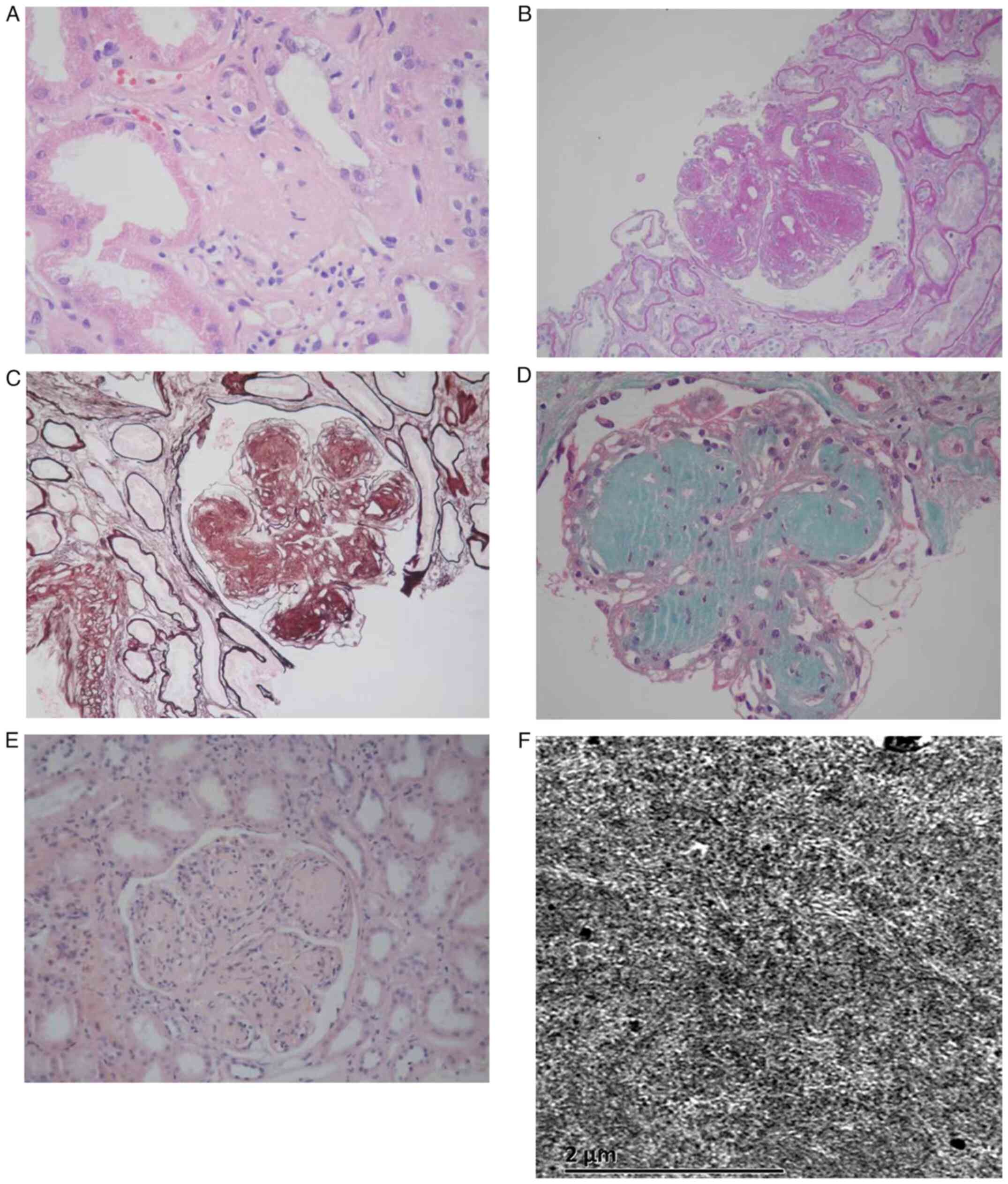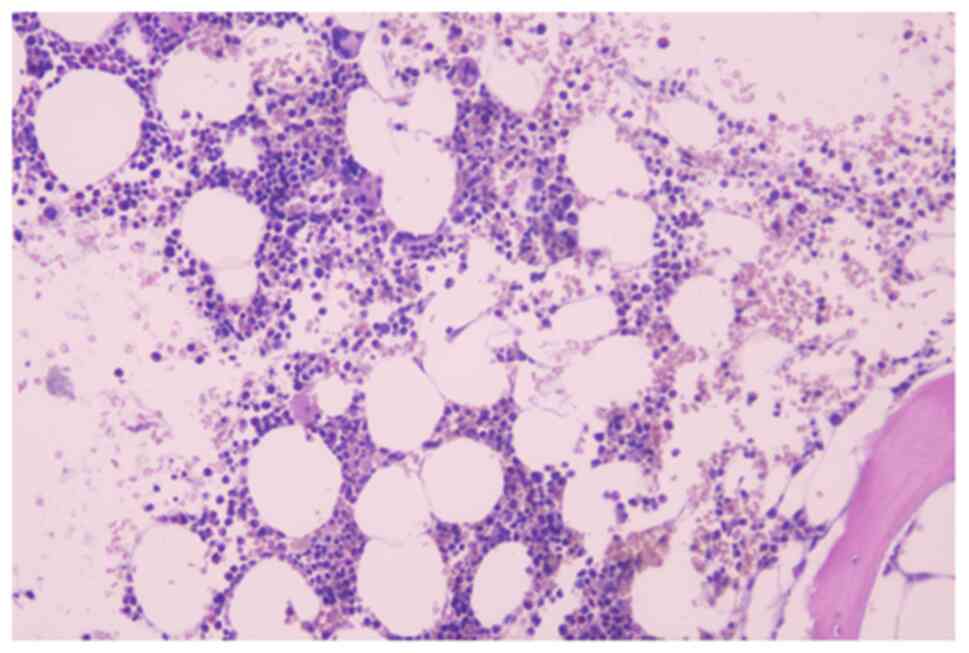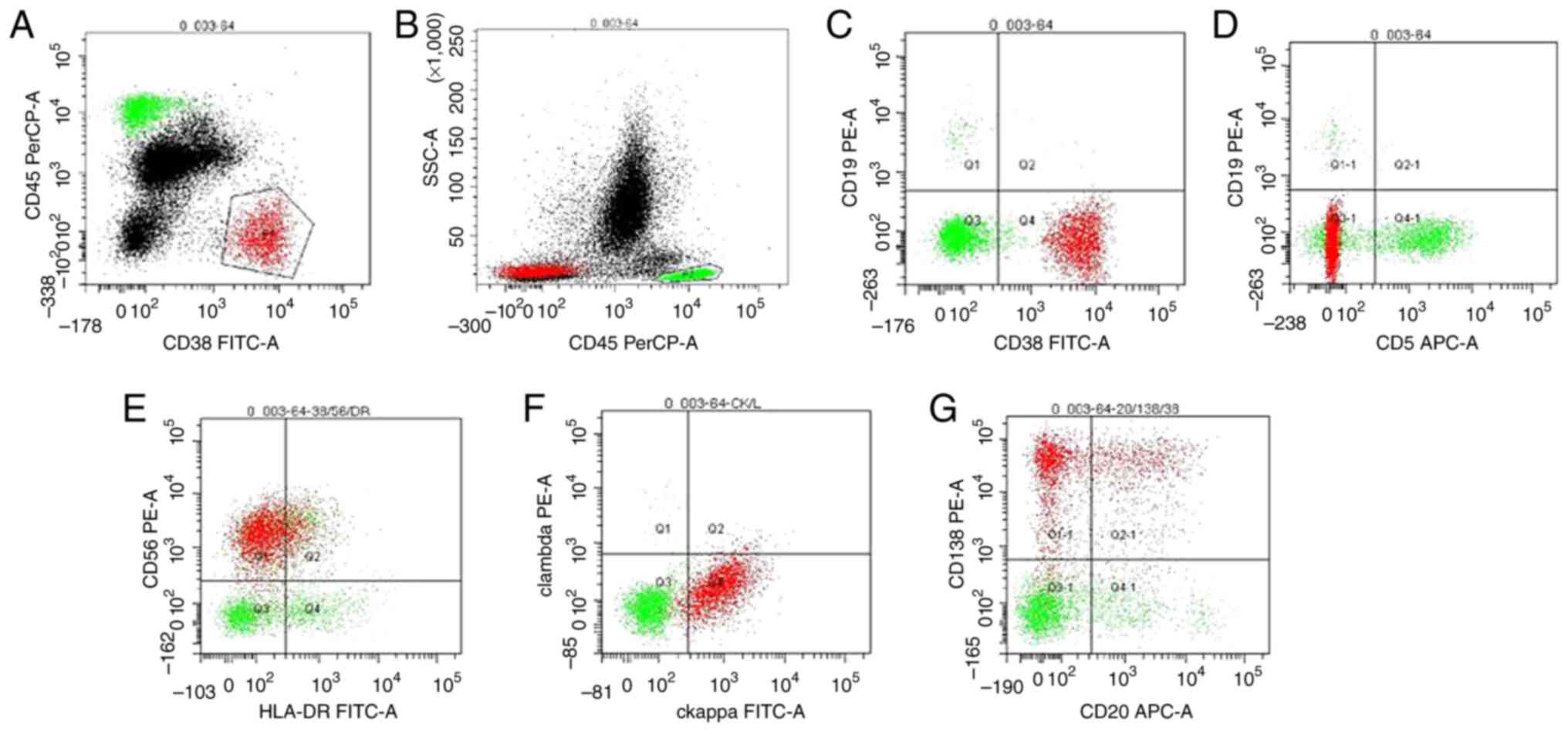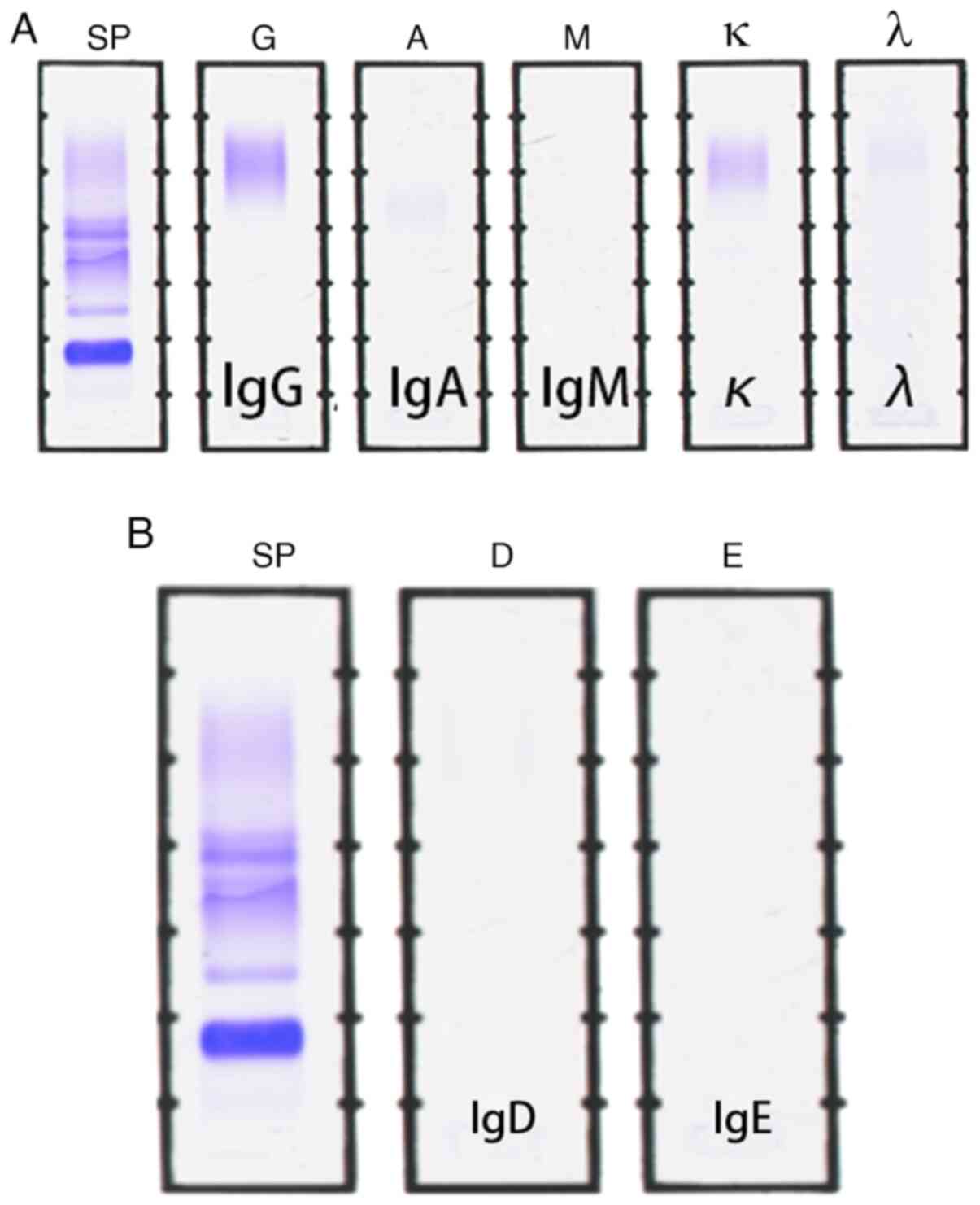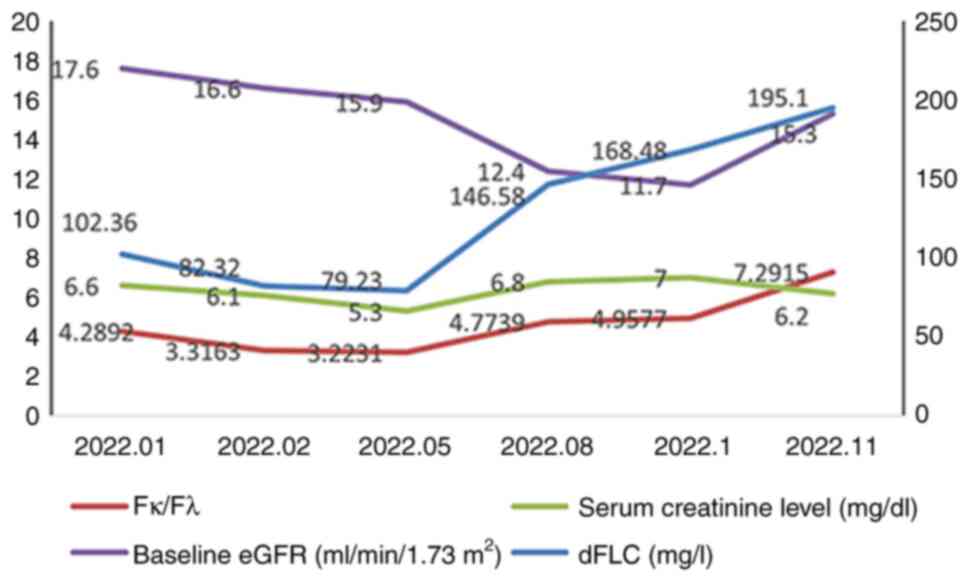Diagnosis of light‑chain deposition disease after renal transplantation: A case report and literature review
- Authors:
- Published online on: June 28, 2024 https://doi.org/10.3892/etm.2024.12628
- Article Number: 339
-
Copyright: © Yue et al. This is an open access article distributed under the terms of Creative Commons Attribution License.
Abstract
Introduction
Light chain deposition disease (LCDD) is characterized by tissue deposition of nonamyloid immunoglobulin light chains produced by clonal proliferation of CD38+ plasma cells. CD38 is involved in various enzymatic activities that control NAD+ levels in the bone marrow niche where the malignant plasma cells grow (1). CD38 is highly and uniformly expressed on human plasma cells and at relatively low levels on normal lymphoid and myeloid cells, and in certain tissues of nonhematopoietic origin, which is closely related to the number and function of T cells through the CD38-NAD+ axis. A small number of cases of LCDD were reported to be secondary to autoimmune diseases, such as Sjogren's syndrome (2,3). To date, the incidence of this disorder has remained undetermined. The diagnosis of LCDD is often missed because of its rarity and morphological similarities. Repeated renal biopsies are essential to establish the diagnosis (4). There is no generally accepted standard treatment for LCDD because of its rarity and the lack of randomized clinical trials. Our patient was initially started on bortezomib combined with dexamethasone (Vd) chemotherapy, and anemia and renal failure developed progressively in the second cycle. The patient was considered to be less responsive to this Vd approach. Certain studies have revealed the importance of CD38 in the inflammatory process during autoimmunity (5-7), and CD38 is expected to serve as a promising therapeutic agent for autoimmune diseases (6,7). CD38 is highly and uniformly expressed on human plasma cells, making anti-CD38 antibody an ideal therapeutic approach against CD38+ aberrant plasma cells and immunomodulatory dynamics for clonal elimination by inducing changes in the bone marrow microenvironment (8). To our knowledge, only a small number of studies have reported on the use of anti-CD38 antibody therapy in patients with LCDD without symptomatic myeloma. Its activity was demonstrated in several studies with high overall response rates, including a small series of 6 patients with LCDD treated with a short course of daratumumab monotherapy (response rate, 100%) (9), a study reporting on the use of anti-CD38 antibody-based therapy in 25 patients with Monoclonal gammopathy of renal significance (LCDD in 20) with a 74% overall response rate (5), and another report indicating a profound hematologic response and favorable renal outcome in 6 out of 7 patients with previously treated LCDD (10). Overall, daratumumab is an effective option for patients with LCDD. The present study reported on the case of a patient who developed LCCD after successful renal transplantation and the use of anti-CD38 antibody.
Case report
A 49-year-old male patient first visited the nephrology unit of Mianyang Central Hospital (Mianyang, China) due to nocturia and lower extremity edema in January 2014. The patient had a history of hypertension and lipoma. On admission, slight pitting edema of the lower extremities was observed during physical examination. Laboratory findings showed severe proteinuria (24-h urine test, 15.98 g/24 h; normal, 0-0.14 g/24 h), hypoproteinemia (serum albumin, 30.81 g/l; normal, 35-55 g/l), hyperlipidemia (triglycerides, 1.76 mmol/l; normal, <1.70 mmol/l), hypercholesterolemia (8.33 mmol/l; normal, <5.2 mmol/l) and renal insufficiency (serum creatinine, 3.6 mg/dl; normal, 0.6-1.4 mg/dl). Urinary ultrasonography revealed that both kidneys had a normal size. Bone marrow smear showed a normal number of plasma cells. Serum or urine immunofixation electrophoresis was not performed at this stage. Ultrasound-guided percutaneous right kidney biopsy was performed in February 2014 and the tissue specimens were sent to KingMed Diagnostics for analysis. Hematoxylin-eosin staining revealed sclerosis in one glomerulus (Fig. 1A); periodic acid-Schiff staining showed nodular changes in the mesangial region (Fig. 1B); periodic acid silver methenamine staining revealed that capillary loops were lobulated (Fig. 1C); Masson trichrome staining showed no obvious fuerythrophilin deposition within the glomeruli (Fig. 1D); and Congo red staining was negative (Fig. 1E). Electron microscopy showed fibrillary deposits along the glomerular basement membrane and mesangial area (Fig. 1F). The biopsy results suggested fibrillary glomerulonephritis. Finally, based on the above, a diagnosis of fibrillary glomerulonephritis was reached. The patient commenced treatment with prednisolone (50 mg once daily) for 8 weeks and tapered by 5 mg every 2 weeks, and reduced to 7.5 mg/day for 3 months. After that, the patient did not receive any treatment and remained in a stable condition. In June 2018, the patient was readmitted to the nephrology unit of Mianyang Central Hospital (Mianyang, China) due to repeated nocturia and lower extremity edema. The patient had serum creatinine levels of 6.6 mg/dl, 24-h urinary protein excretion of 8.65 g/day, serum albumin of 30.78 g/l and total cholesterol of 9.13 mmol/l. The patient was started on prednisolone again for increased serum creatinine and proteinuria. In March 2019, the patient was readmitted to hospital due to an increase in creatinine to 18.9 mg/dl. In March 2019, the patient underwent surgery to create an internal arteriovenous fistula and then began maintenance hemodialysis three times a week. Serum creatinine levels ranged between 5.8 and 12 mg/dl. In April 2020, the patient received a renal allograft transplantation at the West China Hospital of Sichuan University (Chengdu, China). Subsequently, the patient began a triple immunosuppressive regimen consisting of prednisone, tacrolimus and mycophenolate mofetil, and hemodialysis was stopped. In October 2021, the patient visited the Department of Urological Surgery at West China Hospital of Sichuan University (Chengdu, China) due to worsening serum creatinine levels after renal transplantation. The patient underwent allograft kidney biopsy. The allograft kidney specimens were sent to Tongji Hospital, Tongji Medical College (Wuhan, China), and the report indicated that all of the glomeruli showed focal mesangial matrix hyperplasia, nodular enhancement and no evidence of rejection. There was no obvious matrix increase and tubular atrophy in the renal interstitium [no high-definition images were acquired, as Tongji Hospital is an external hospital. The analyses were performed according to the protocols of Tongji Hospital (Tongji Medical College, Wuhan, China)]. Immunofluorescence staining, also performed at Tongji Hospital according to their in-house procedures, revealed diffuse linear deposition of κ light chain along the glomerular basement membrane, tubular basement membranes and small vascular intima. Electron microscopy showed electron-dense deposits in the outer aspect of the tubular basement membrane, mesangium and basement membrane of the capillary endothelium, confirming the pathological diagnosis of LCDD (only a pathological copy report with a small number of unclear images was available; Fig. S1A and B). Bone marrow biopsy showed normal numbers of plasma cells (Fig. 2) and flow cytometry revealed 7.1% clonal plasma cells (Fig. 3). Serum immunofixation electrophoresis was negative (Fig. 4A and B). The above-mentioned analyses were performed at West China Hospital, Sichuan University (Chengdu, China) according to standard protocols. In November 2021, the patient first visited the hematology department at West China Hospital of Sichuan University (Chengdu, China). Serum and urine immunofixation electrophoresis was negative. Serum free κ light chain was 317.81 mg/l (normal, 3.3-19.4 mg/l) and free λ light chain was 23.05 mg/l (normal, 5.7-26.3 mg/l), with a κ/λ a light chain ratio of 13.79 (normal, 0.26-1.65). The patient's serum creatinine level was 3.6 mg/dl and hemoglobin was 115 g/l (normal, 130-175 g/l). Finally, he was diagnosed with LCDD. He was transferred to our hospital and subsequently started on Vd chemotherapy [bortezomib (Shandong Qilu) 1.3 mg/m2 subcutaneously combined with dexamethasone 20 mg intravenously weekly, in a 35-day cycle]. In December 2021, during the second cycle of the Vd regimen, his creatinine level was increased to 7.6 mg/dl and hemoglobin was decreased to 66 g/l. The patient was considered to be less responsive to the Vd regimen and anti-CD38 antibody-based chemotherapy was initiated in January 2022. Daratumumab (Cilag AG) is an anti-CD38 monoclonal antibody, which was administered intravenously at 16 mg/kg weekly for 8 weeks, followed by every 2 weeks for 16 weeks, and then every 4 weeks thereafter. Thrice-a-week dialysis was maintained. The patient's hemoglobin level improved to 125 g/l; furthermore, serum creatinine levels ranged between 5.3 and 7 mg/dl and serum free κ light chain ranged between 114.87 and 226.11 mg/l during the use of Daratumumab (Fig. 5). In this period, the best response achieved was hematological partial response (>50% reduction in dFLC); the patient's renal function did not improve and he remained in end-stage kidney disease. The patient died of coronavirus disease complications in June 2023, which was unrelated to his condition.
Discussion
LCDD is a rare monoclonal gammopathy that affects the kidneys (11,12), and represents a diagnostic and therapeutic challenge. Only a small number of studies have reported LCDD as a recurrent disease or a de novo entity after renal transplantation. While the exact mechanism remains elusive, the condition may arise from the current immunosuppressive status and minor plasma cell clone escaping from the tumor immunity surveillance, finally resulting in light chain deposition (13). To date, no evidence-based consensus has been reached for the treatment of LCDD. Treatment strategies comprise systemic chemotherapy with or without autologous stem cell transplantation to eliminate the plasma cell burden in the bone marrow that produces light chains. The bortezomib-based regimen is the most common chemotherapy protocol (14), and anti-CD38 antibody is also an effective option for patients with LCDD due to its direct antitumor and immunomodulatory mechanism (5,9,10,15,16).
As part of the present study, 12 previously reported cases of LCDD diagnosed after kidney transplantation were reviewed and summarized (Table I) (4,17-25). These 12 cases comprised 8 males and 1 female, and the sex of the other 3 cases was unknown. This suggests greater male susceptibility. The median age was 52 years (range, 28-72 years). Serum immunofixation electrophoresis was available in 10 of 12 patients and was negative in 5. Serum immunoglobulin types seemed to be nonspecific. Urine immunofixation electrophoresis was available in 8 of 12 patients and negative in 2. Five of 10 patients had negative serum immunofixation electrophoresis for monoclonal proteins, and 6 of 12 patients were confirmed to have de novo LCDD after review of their original kidney biopsies. Unfortunately, serum and urine monoclonal light chain could not be detected in the patient of the present study. Retrospective analysis of the patient's first renal biopsy specimen was not possible due to it being unavailable, and thus, it remains undetermined whether LCDD was recurrent or de novo. Most patients with delayed diagnosis had negative serum immunofixation electrophoresis. Serum and urine immunofixation electrophoresis was negative in 3 of 9 patients. The positive rate of blood M protein (5/10 patients) was lower than corresponding urine M protein (6/8 patients). As for free light chain assays, increased involved serum free light chains (4/4), an abnormal κ/λ ratio (4/4) and difference between involved and uninvolved free light chains (dFLC) (3/3) were reported. The determination of serum free light chains may be crucial for identifying LCDD in clinical practice.
There is no standard clinical treatment for LCDD due to its rarity. Currently, treatment is based on regimens used in multiple myeloma and amyloid light chain amyloidosis, and it is generally accepted that the bortezomib-based regimen represents a successful first-line therapy (14,26). The patient of the present study was started on a Vd regimen and then switched to the anti-CD38 antibody regimen. Anti-CD38 antibody can improve the depth of response and prevent the progression of renal failure in treated LCDD (9,10). No severe infusion-related reaction and no severe grade 4 adverse event occurred during the course of anti-CD38 antibody therapy. The daratumumab-based regimen does not belong to the experimental treatment, which is an effective option for patients with LCDD (9,10). The best response achieved by the patient of the present study was hematological partial response (>50% reduction in dFLC). However, the patient's renal function did not improve and he remained in end-stage kidney disease. Milani et al (10) also reported that two patients progressed to end-stage renal disease and one of them did not respond to anti-CD38 antibody, and the other experienced further deterioration of renal dysfunction. Thus, anti-CD38 antibody is effective in treated LCDD but it may not overcome the marked deterioration of renal function. Further large multicenter retrospective and prospective studies are required to assess the role of anti-CD38 antibody.
A limitation of the present study was that for the allograft kidney biopsy specimens, which were sent to an external hospital for analysis, no high-definition images were acquired and scale bar/magnification details of light microscopy, immunofluorescence and electron microscopy of the biopsy were not available.
In conclusion, a panel of serum immunofixation electrophoresis, urine immunofixation electrophoresis and serum free light chain assays can improve the early recognition of LCDD. Early clone-directed therapy can result in a deeper hematological response and better renal outcome. Anti-CD38 antibody may help patients with LCDD obtain a rapid and profound hematological response that preserves kidney function. However, it may not overcome the marked deterioration of renal function in LCDD.
Supplementary Material
Pathological findings of the allograft renal biopsy. (A) Immunofluorescence staining revealed diffuse linear deposition of κ light chain along the glomerular basement membrane, tubular basement membranes and small vascular intima. (B) Electron microscopy showed electron-dense deposits in the outer aspect of the tubular basement membrane, mesangium and basement membrane of the capillary endothelium (magnification, x2,500).
Acknowledgements
Not applicable.
Funding
Funding: No funding was received.
Availability of data and materials
The data generated in the present study may be requested from the corresponding author.
Authors' contributions
YZ, FX and JY contributed to the conception and design of the work. JY and JW contributed to the acquisition, analysis and interpretation of data. JY, YZ and QZ researched the literature and drafted the manuscript. JY and FX checked and confirm the authenticity of all the raw data. JY and FX reviewed and edited the final manuscript. All authors read and approved the final version of the manuscript and agree to be accountable for all aspects of the work in ensuring that questions related to the accuracy or integrity of any part of the work are appropriately investigated and resolved.
Ethics approval and consent to participate
Written informed consent prior to and regarding the treatment protocol was obtained from the patient analyzed in the present study. The study was approved by the Ethics Committee of Mianyang Central Hospital (Mianyang, China; approval no. S2021080).
Patient consent for publication
Written informed consent for publication was obtained from the individual participant included in the study.
Competing interests
The authors declare that they have no competing interests.
References
|
Bisht K, Fukao T, Chiron M, Richardson P, Atanackovic D, Chini E, Chng WJ, Van De Velde H and Malavasi F: Immunomodulatory properties of CD38 antibodies and their effect on anticancer efficacy in multiple myeloma. Cancer Med. 12:20332–20352. 2023.PubMed/NCBI View Article : Google Scholar | |
|
Arrossi AV, Merzianu M, Farver C, Yuan C, Wang SH, Nakashima MO and Cotta CV: Nodular pulmonary light chain deposition disease: an entity associated with Sjögren syndrome or marginal zone lymphoma. J Clin Pathol. 69:490–496. 2016.PubMed/NCBI View Article : Google Scholar | |
|
Steward M, Yu JH and Gibbons MA: Sjögren's syndrome as a cause of both lymphoid interstitial pneumonia and light chain deposition disease in a single patient. BMJ Case Rep. 15(e249747)2022.PubMed/NCBI View Article : Google Scholar | |
|
Aoudia R, Bacha MM, Ounissi M, Gaied H, Jerbi M, Abderrahim E, Abdallah TB and Goucha R: Monoclonal gammopathy of renal significance with light-chain deposition disease in kidney transplantation. Saudi J Kidney Dis Transpl. 30:1161–1165. 2019.PubMed/NCBI View Article : Google Scholar | |
|
Li W, Liang L, Liao Q, Li Y and Zhou Y: CD38: An important regulator of T cell function. Biomed Pharmacother. 153(113395)2022.PubMed/NCBI View Article : Google Scholar | |
|
Ye X, Zhao Y, Ma W, Ares I, Martínez M, Lopez-Torres B, Martínez-Larrañaga MR, Wang X, Anadón A and Martínez MA: The potential of CD38 protein as a target for autoimmune diseases. Autoimmun Rev. 22(103289)2023.PubMed/NCBI View Article : Google Scholar | |
|
Holzer MT, Ruffer N, Huber TB, Kötter I, Ostendorf L and Krusche M: Daratumumab for autoimmune diseases: A systematic review. RMD Open. 9(e003604)2023.PubMed/NCBI View Article : Google Scholar | |
|
De Novellis D, Fontana R, Giudice V, Serio B and Selleri C: Innovative anti-CD38 and anti-BCMA targeted therapies in multiple myeloma: Mechanisms of action and resistance. Int J Mol Sci. 24(645)2022.PubMed/NCBI View Article : Google Scholar | |
|
Kastritis E, Rousakis P, Kostopoulos IV, Gavriatopoulou M, Theodorakakou F, Fotiou D, Dialoupi I, Migkou M, Roussou M, Kanellias N, et al: Consolidation with a short course of daratumumab in patients with AL amyloidosis or light chain deposition disease. Amyloid. 28:259–266. 2021.PubMed/NCBI View Article : Google Scholar | |
|
Milani P, Basset M, Curci P, Foli A, Rizzi R, Nuvolone M, Guido R, Gesualdo L, Specchia G, Merlini G, et al: Daratumumab in light chain deposition disease: Rapid and profound hematologic response preserves kidney function. Blood Adv. 4:1321–1324. 2020.PubMed/NCBI View Article : Google Scholar | |
|
Leung N, Bridoux F, Batuman V, Chaidos A, Cockwell P, D'Agati VD, Dispenzieri A, Fervenza FC, Fermand JP, Gibbs S, et al: The evaluation of monoclonal gammopathy of renal significance: A consensus report of the International Kidney and Monoclonal Gammopathy Research Group. Nat Rev Nephrol. 15:45–59. 2019.PubMed/NCBI View Article : Google Scholar | |
|
Kobayashi A, Takeda A, Shinjo H, Iguchi D, Ito C, Okada E, Goto N, Futamura K, Okada M, Hiramitsu T, et al: Light chain deposition disease recurrence in renal allograft after long-term remission. Nephron. 147 (Suppl 1):96–100. 2023.PubMed/NCBI View Article : Google Scholar | |
|
Li J, Koerner J, Basler M, Brunner T, Kirk CJ and Groettrup M: Immunoproteasome inhibition induces plasma cell apoptosis and preserves kidney allografts by activating the unfolded protein response and suppressing plasma cell survival factors. Kidney Int. 95:611–623. 2019.PubMed/NCBI View Article : Google Scholar | |
|
Masood A, Ehsan H, Iqbal Q, Salman A and Hashmi H: Treatment of light chain deposition disease: A systematic review. J Hematol. 11:123–130. 2022.PubMed/NCBI View Article : Google Scholar | |
|
Shimamura Y, Ogawa Y, Takizawa H, Hayashi T and Sakurai Y: Light chain deposition disease diagnosed using computed tomography-guided kidney biopsy. Cureus. 13(e15102)2021.PubMed/NCBI View Article : Google Scholar | |
|
Tsushima T, Suzuki T, Terao T, Miura D, Narita K, Takeuchi M, Shimuzu A and Matsue K: Light chain deposition disease involving kidney and liver in a patient with IgD myeloma. BMC Nephrol. 22(40)2021.PubMed/NCBI View Article : Google Scholar | |
|
Heybeli C, Alexander MP, Bentall AJ, Amer H, Buadi FK, Dean PG, Dingli D, Dispenzieri A, El Ters M, Gertz MA, et al: Kidney transplantation in patients with monoclonal gammopathy of renal significance (MGRS)-associated lesions: A case series. Am J Kidney Dis. 79:202–216. 2022.PubMed/NCBI View Article : Google Scholar | |
|
Nambirajan A, Bhowmik D, Singh G, Agarwal SK and Dinda AK: Monoclonal gammopathy of renal significance with light-chain deposition disease diagnosed postrenal transplant: A diagnostic and therapeutic challenge. Transpl Int. 28:375–379. 2015.PubMed/NCBI View Article : Google Scholar | |
|
Kuppachi S, Holanda D and Thomas CP: Light chain deposition disease after kidney transplantation with long graft survival: Case report. Transplant Proc. 48:255–258. 2016.PubMed/NCBI View Article : Google Scholar | |
|
Jimenez-Zepeda VH, Vajpeyi R, John R and Trudel S: Light chain deposition disease affecting the gastrointestinal tract in the setting of post-living donor kidney transplantation. Int J Hematol. 96:125–131. 2012.PubMed/NCBI View Article : Google Scholar | |
|
Tanenbaum ND, Howell DN, Middleton JP and Spurney RF: Lambda light chain deposition disease in a renal allograft. Transplant Proc. 37:4289–4292. 2005.PubMed/NCBI View Article : Google Scholar | |
|
Larsen T, Hammer A and Jørgensen KA: Recurrence of light-chain deposition disease after renal transplantation. Scand J Urol Nephrol. 42:187–188. 2008.PubMed/NCBI View Article : Google Scholar | |
|
Ecder T, Tbakhi A, Braun WE, Tubbs RR, Myles J and McMahon JT: De novo light-chain deposition disease in a cadaver renal allograft. Am J Kidney Dis. 28:461–465. 1996.PubMed/NCBI View Article : Google Scholar | |
|
Horike K, Takeda A, Otsuka Y, Inaguma D, Goto N, Watarai Y, Uchida K and Morozumi K: A case of recurrent light chain deposition disease after living-related renal transplantation-Detailed process of the recurrence. Clin Transplant. 26 (Suppl 24):64–69. 2012.PubMed/NCBI View Article : Google Scholar | |
|
Taneda S, Honda K, Horita S, Koyama I, Teraoka S, Oda H and Yamaguchi Y: Light chain deposition disease after renal transplantation. Am J Kidney Dis. 52:621–625. 2008.PubMed/NCBI View Article : Google Scholar | |
|
Ziogas DC, Kastritis E, Terpos E, Roussou M, Migkou M, Gavriatopoulou M, Spanomichou D, Eleutherakis-Papaiakovou E, Fotiou D, Panagiotidis I, et al: Hematologic and renal improvement of monoclonal immunoglobulin deposition disease after treatment with bortezomib-based regimens. Leuk Lymphoma. 58:1832–1839. 2017.PubMed/NCBI View Article : Google Scholar |



